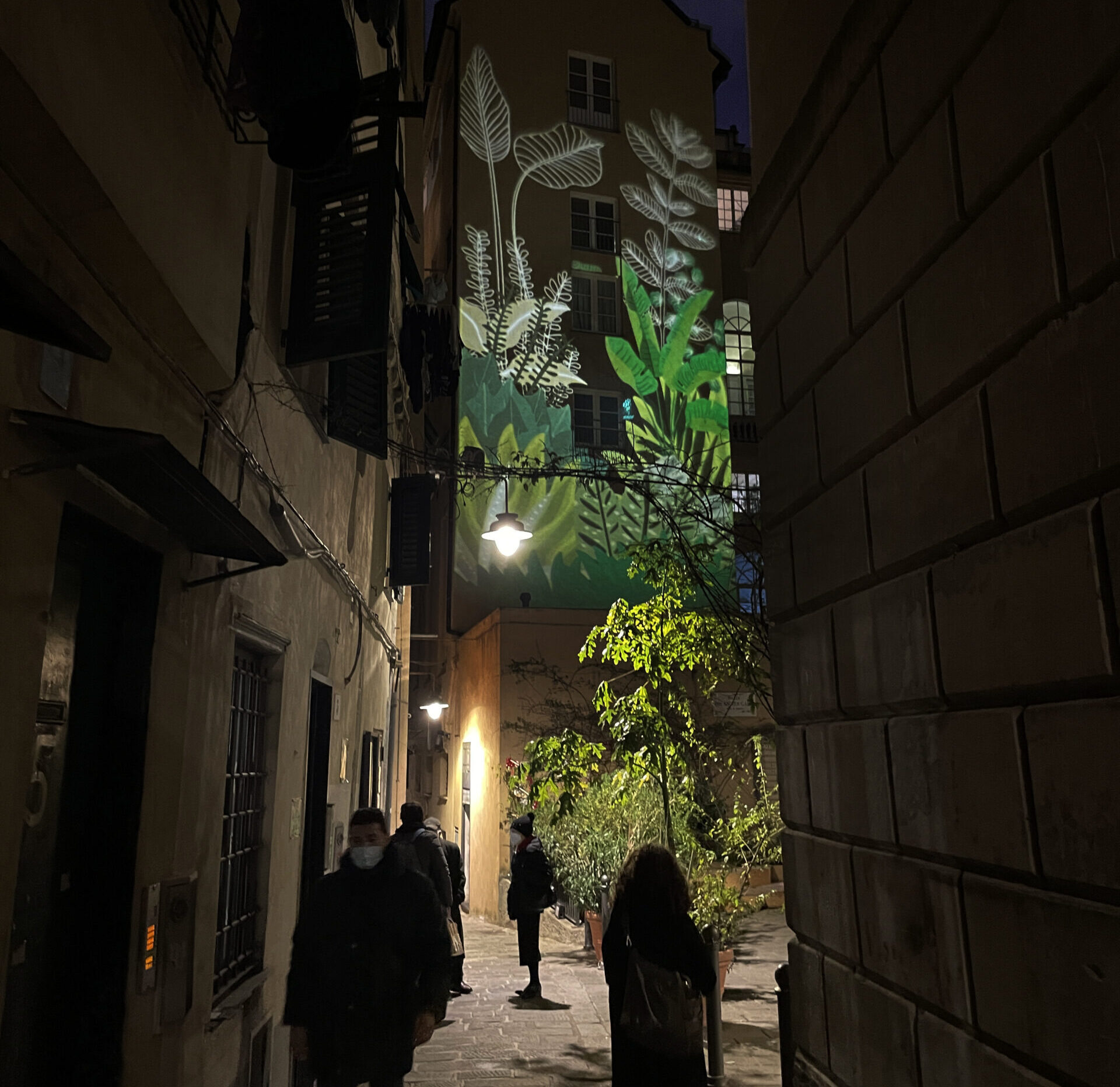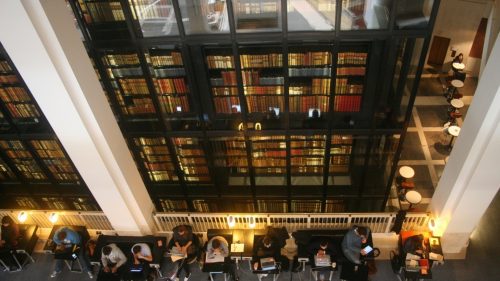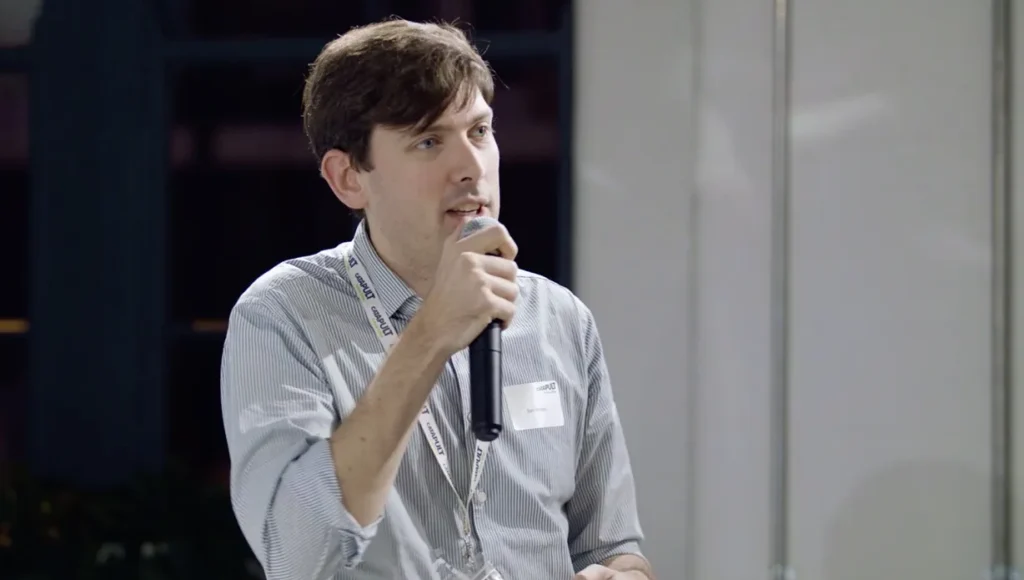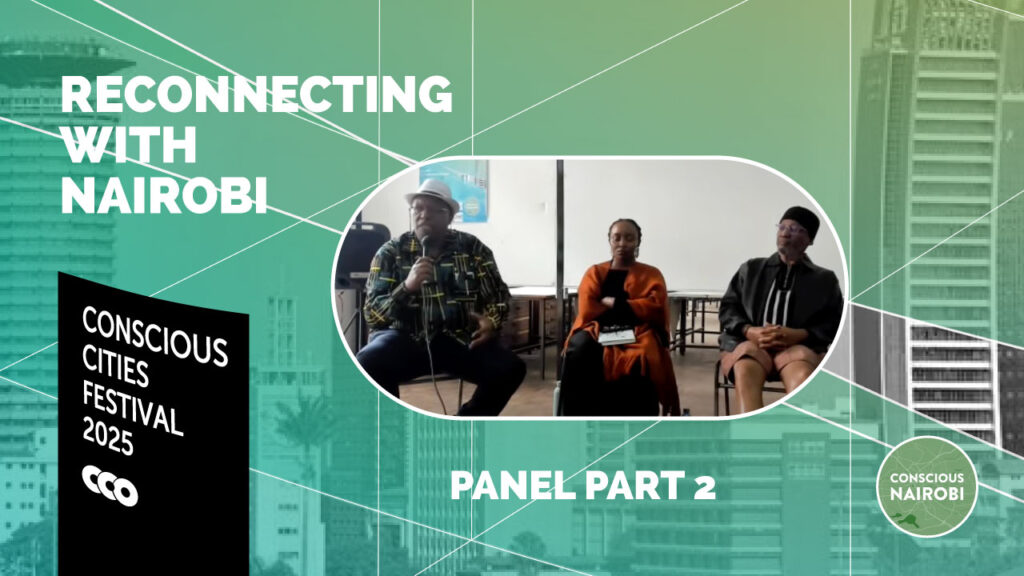In the field of urban design and environmental psychology, the imperative to foster a deep sense of place and cultivate attachment to the environment is paramount. These principles not only enhance individual well-being, but also serve as cornerstones for the vibrancy and resilience of communities in neighbourhoods and cities.
In this article, I posed the question: can lighting interventions help in cultivating and sustaining a sense of place? Based on a compelling case study, we examine the role of light in urban space and its potential to enhance aesthetic experience as a means of re-uniting the local community.
Light
The influence of light on humans, as electromagnetic radiation visible to the human eye transcends the visual realm, exerting non-visual effects on human physiology and psychology. Light exposure is intertwined with circadian rhythms, hormonal regulation and mood modulation, profoundly affecting general well-being1. Properly designed lighting has immense potential to enhance the aesthetic impact of a place, enriching its visual appeal and creating dynamic atmospheres2.
In an urban environment, thoughtful lighting strategies are needed to transform places into vibrant centres of activity3. Well-designed lighting interventions have the potential to catalyse social interaction, foster cultural exchange and amplify the sense of place within urban environments, thus enriching the urban experience of both residents and visitors.
Beauty in the city
Is beauty considered in urban planning, especially in the era of Smart Cities?
Aesthetics played an important role in early urban planning efforts of ancient civilisations. The planning of cities such as Athens and Rome was not only functional, but also aimed at creating visually pleasing spaces4.
Today, cities face several issues, including the transition to sustainability, as well as a system of strategies that put the safety of citizens at the forefront. Both of these factors have an effect on those who experience specific public spaces on a daily basis as well as those who are just passing through, thus necessitating an approach that goes far beyond large-scale planning. It requires finding solutions in direct observation of the urban experience.
Can the beauty of a space become a method to foster safer environments and a greater sense of belonging? Perhaps this question needs to be explored in more depth, specifically the issue of what beauty is in the urban context, and beyond.
A complex topic that can be examined from both a subjective and objective perspective, urban beauty concerns not only visual aesthetics, but also functionality, sustainability and the socio-cultural impact of spaces. This interrelation of qualities that amount to what can be considered ‘beautiful’ requires contextualising assessment within the place itself, as well as considering the intended social impact.
Case study – Lighting for Genoa
The ‘Lighting for Genoa’ project emerges as a dynamic response to multifaceted urban challenges, addressing issues of local pride, safety and the cultivation of pro-environmental behaviour within the historic centre of Genoa. This engagement takes place in a context where the community’s connection to the urban environment is often weakened, leaving spaces with a sense of detachment and abandonment.
Illuminazione per Genova’ is the first Italian example of multiple interventions of permanent lighting as an element of urban regeneration. Promoted by the Municipality of Genoa, conceived and co-ordinated by Condiviso.coop of Genoa under the creative direction of Lighting Designer Stefania Toro, twelve lighting designers were called to intervene in 10 different squares in the historic centre of Genoa.
The project unfolds as a symphony of innovation and collaboration, with an inclusive approach at its core that seeks to bridge the gap between urban planning and community aspirations.
Many urban areas, particularly historic centres, have seen a decline in local pride and community engagement. Issues such as lack of security, poor environmental practices and a general lack of connection to local heritage can exacerbate these problems. In the historic centre of Genoa, these challenges were particularly pressing and required innovative solutions to improve safety and promote a sense of community cohesion and environmental responsibility.
Recognising the transformative power of community engagement, the initiative intentionally involved residents in the design process. Promoting dialogue and understanding, the project aims to redefine the urban aesthetic by amplifying what the community perceives as beautiful.
By conducting surveys and interacting with residents, the project team gathered information about the community’s perspectives on the beauty, safety and functionality of public spaces. This participatory approach ensured that the interventions were meaningfully reflected the needs and desires of the community, as light installations are not simply ornaments, but rather tools that can elevate the charm and intrinsic character of public spaces.
How, then, do we design to accentuate what people see as beautiful?
Designing to highlight the perceived beauty of a place means understanding and amplifying the elements that inhabitants and visitors find most attractive. In the case of Genoa, this meant using light installations to create new visual perspectives and enhance existing architectural features. The aim was to create a narrative using light that resonates with the community’s sense of identity and pride. By integrating artistic lighting, the project aims to transform everyday spaces into engaging and aesthetically pleasing environments.
The pilot square, the first to be lit under the guidance of lighting designer Stefania Toro, transformed this square with energy efficient lighting that not only illuminated the space, but also highlighted its historical and cultural significance.
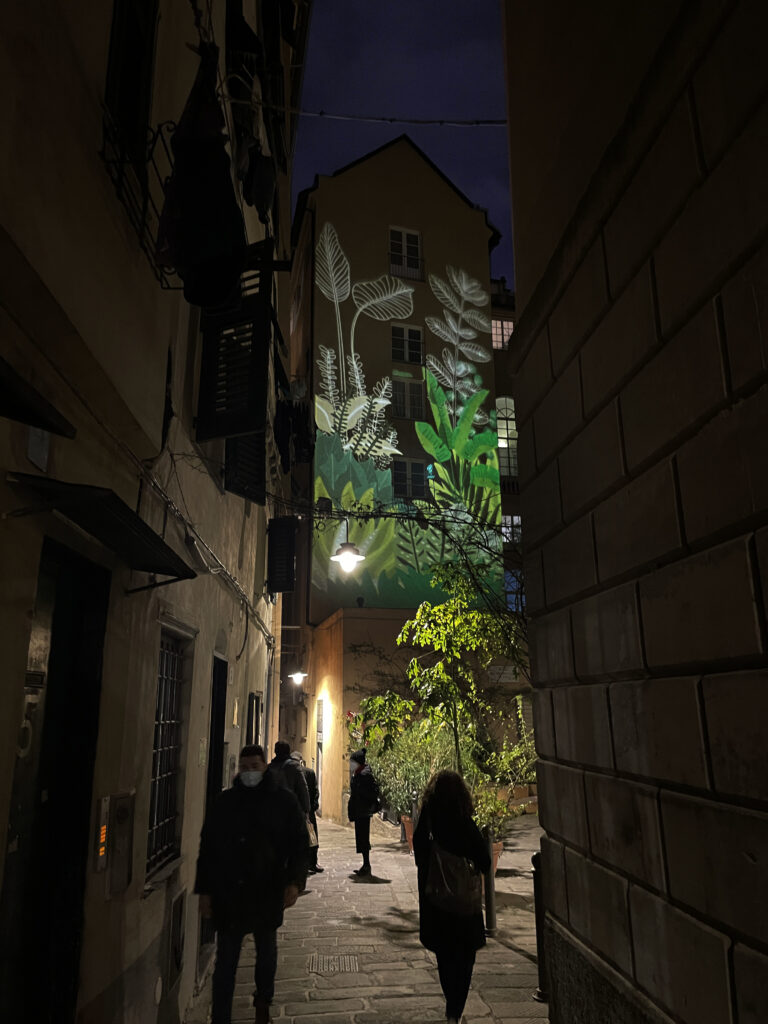
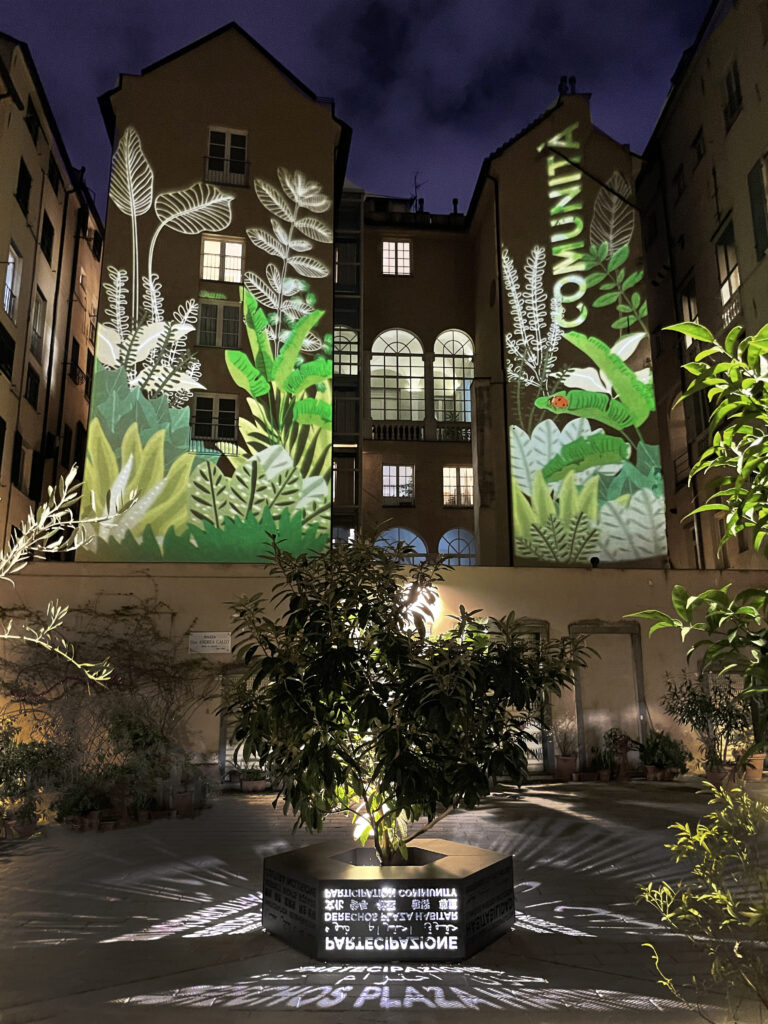
Stefania, who is local, knew both the problems and advantages of the square and focused her concept on these. The result is the creation of a seat placed in the centre of the square and around a symbolic tree planted in 2014 in memory of a much-loved local parish priest. During the day the square creates opportunities for aggregation and sociability. At nightfall the square turns into a luminous lantern to project evocative words in different languages onto the ground, as a testimony to the interculturalism and spirit of inclusion that characterises the place. In addition to this, there is a projection on the façade of the building to the east of the square, reproducing illustrations of plants and vegetation out of scale to represent the wishes and actions undertaken by citizens over the years.
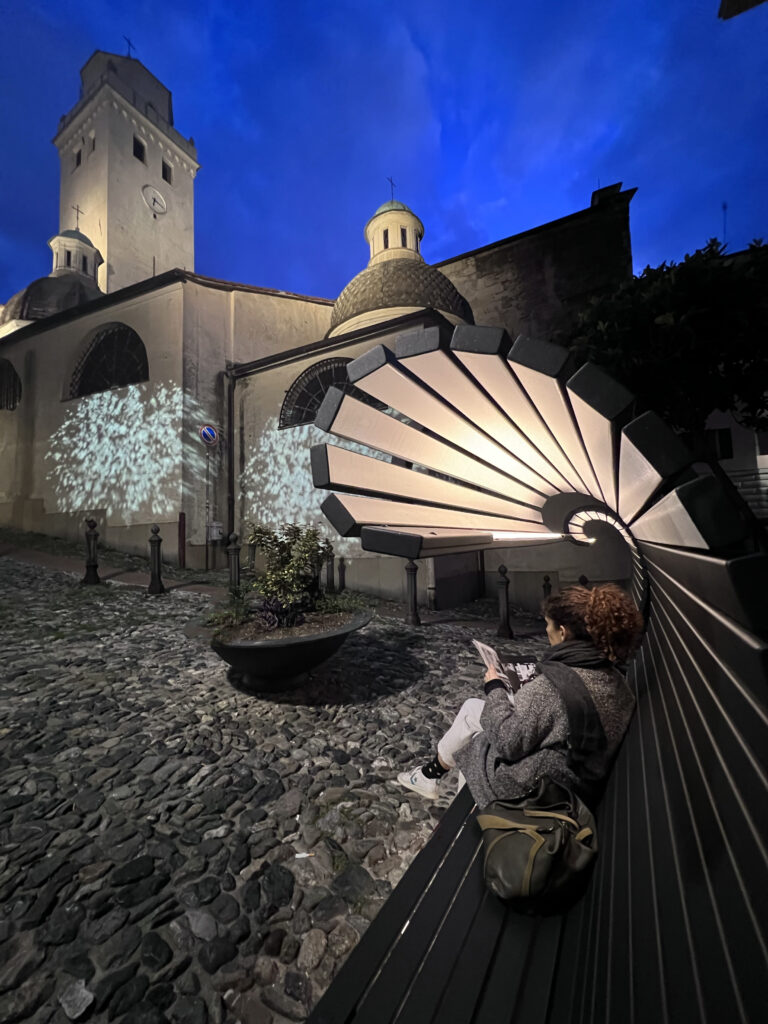
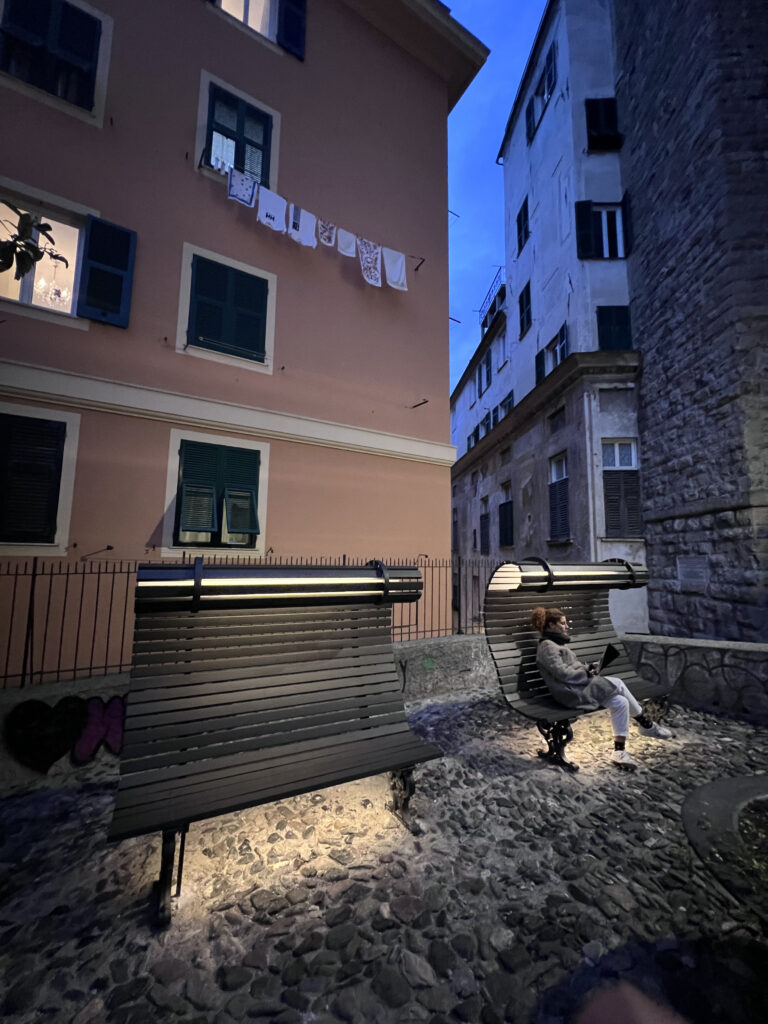
Another square in the project is ‘Salita alla Torre degli Embriaci’ by designers Giorgia Brusemini and Carla Morganti, who worked to emphasise the location’s historic architecture, using light to guide visitors and create a sense of discovery. Their lighting design intervention is in fact intended to make this urban space come alive even after sunset, inviting people to new practices of socialisation and appreciation of varied cultural experiences such as reading in the open air at night. The structural modification of the existing benches, which now accommodate a gentle light, makes it possible to accommodate two or more readers at night. The installation is completed with poetic and evocative projections of light filtering through the leaves and branches (Komorebi), which accentuate the natural atmosphere already present in the place.
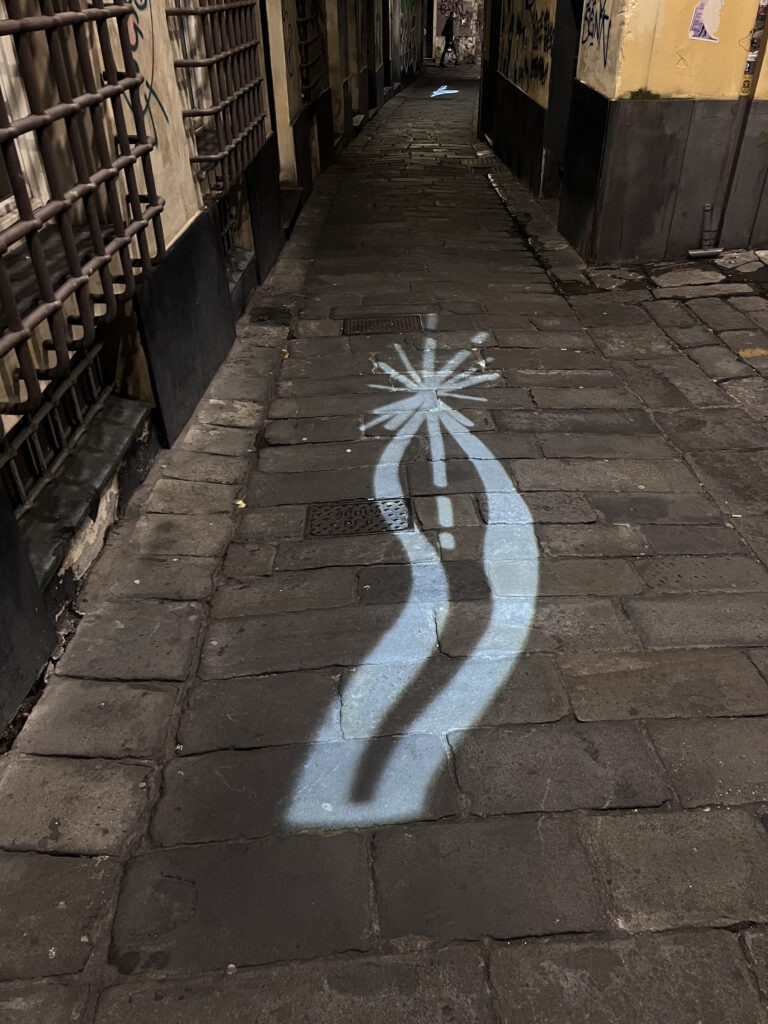
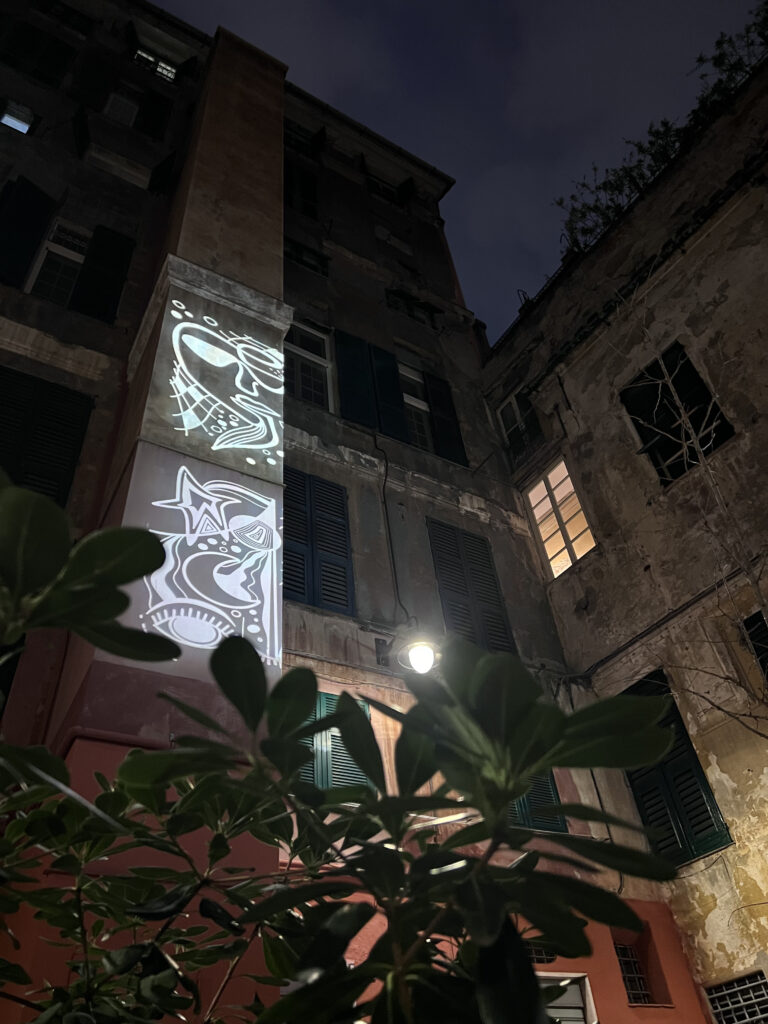
Another example is Piazza Valoria by lighting designer Camila Blanco, whose lighting concept, developed through a series of projections designed in collaboration with local artists’ associations. It was conceived with the desire to emphasise the community life in the square, as if it were the living room of a house inhabited by the whole city. ‘Streets as corridors, the square as the living room: people will feel even more the sense of belonging to the city, entering a space that is theirs, but at the same time belongs to everyone.’
My contribution to the project, in Piazza della Lepre, was conceived in conjunction with another adjacent square, Piazza Cambiaso, by lighting designer Giusy Gallina. where the concept studied together the use of light to pose questions and offer moments of reflection.
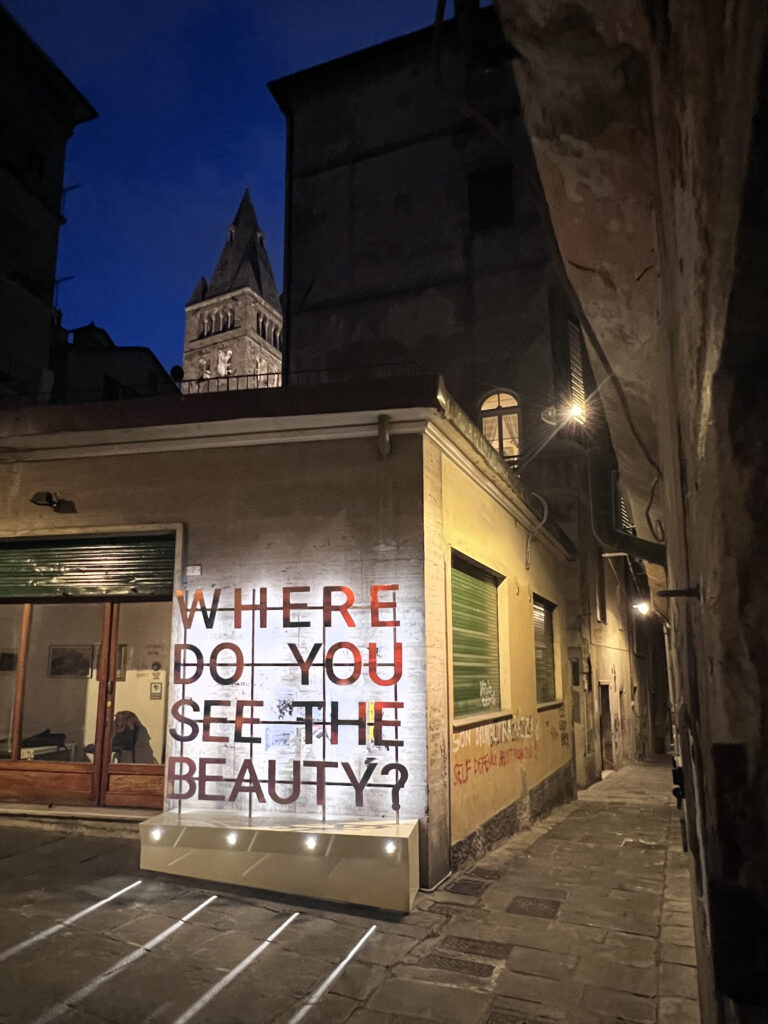
Piazza della Lepre, located in the historic centre of Genoa is known for its lively nightlife. The installation presents a light artwork with the question ‘Where do you see beauty?’, encouraging residents and visitors to reflect and appreciate their surroundings.
The choice of this question stemmed from a broad involvement of the local community, prompting people to look at their surroundings with new eyes and fostering a deeper connection with the place. Through the use of the English language, the installation invites interaction from both long-term residents and tourists. This inclusive approach ensures a wide resonance of the artwork, promoting a shared sense of place and reflection on the unique beauty of the area.
Piazza Cambiaso, known as the ‘theatre square’ due to its proximity to a multi-purpose arts centre was transformed with an installation that reflects the collective voice of residents, making it a true representation of local feeling. The project, which included a survey of local residents to gather their opinions and aspirations for the square uses the responses to shape light projections, creating a dynamic and participatory artwork that evolves with community input. In addition, a permanent sign in the square shows an important response, providing a focal point that remains visible throughout the day: ‘Everywhere’. The lighting design also includes an orientation system connecting Piazza Cambiaso with Piazza della Lepre through light lines projected onto the ground and building entrances, imitating natural day-time patterns.
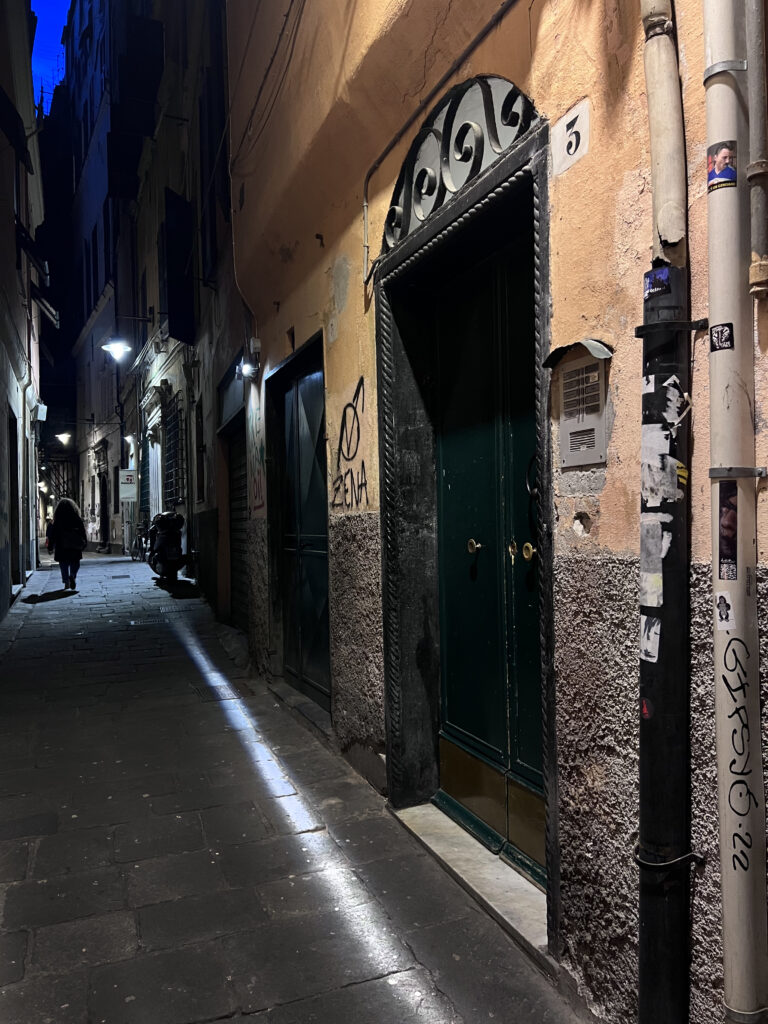
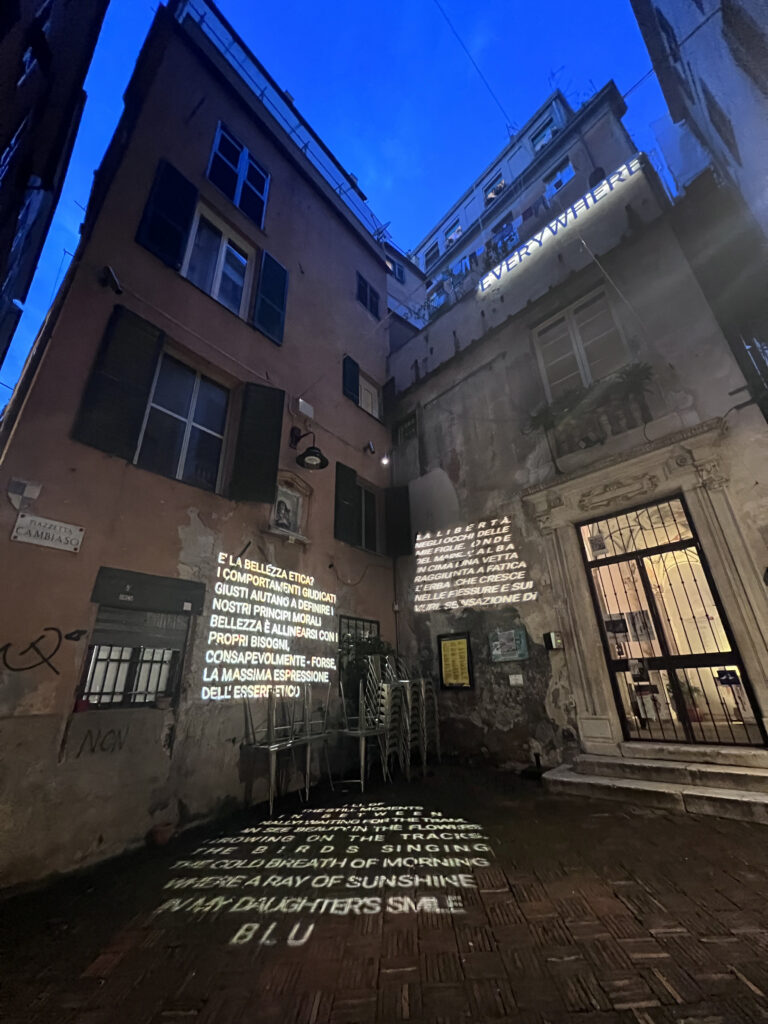
Right: Piazza Cambiaso by Giusy Gallina
In summary, the light installations in Piazza della Lepre and Piazza Cambiaso were designed to complement each other, creating a cohesive narrative linking the two squares.
The ‘Lighting for Genoa’ project exemplifies how thoughtful design and community involvement can address urban challenges, enhance public spaces and promote a sense of pride and security. Through the strategic use of light, the project succeeded in revitalising parts of Genoa’s historic centre, creating a lasting positive impact on the community and its environment.
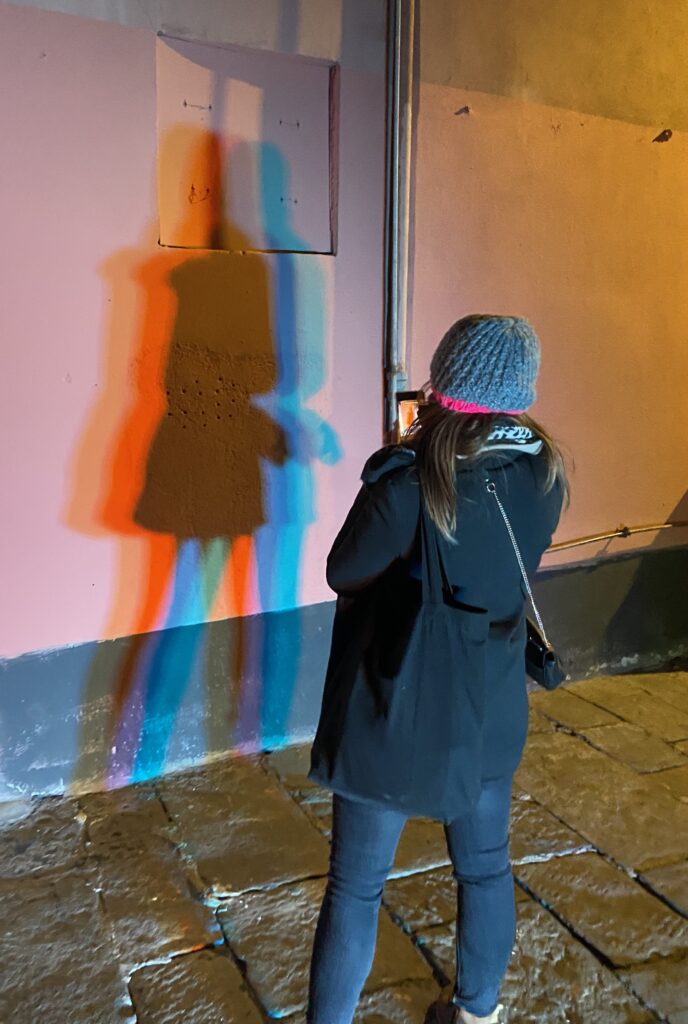
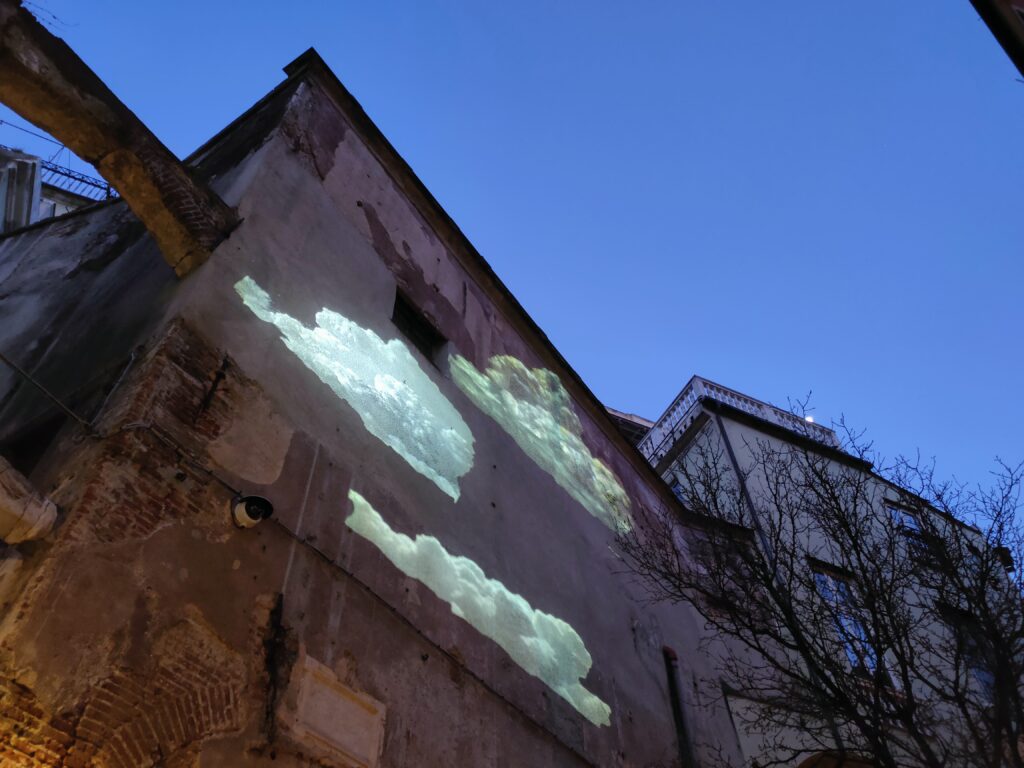

Centre: Piazza Inferiore del Roso by Liliana Iadeluca
Right: Piazza San Pancrazio by Elettra Bordonaro and Argun Paragamyan
Below is the complete list of interventions of the ‘Lighting for Genoa’ project:
- Piazza Don Gallo by Stefania Toro
- Piazza Inferiore del Roso by Liliana Iadeluca
- Salita alla Torre degli Embriaci by Giorgia Brusemini and Carla Morganti
- Piazza Stella by Beatrice Bertolini and Marta Mannino
- Piazza della Lepre by Martina Frattura & Whitepure
- Piazza Cambiaso by Giusy Gallina
- Piazza Valoria by Camila Blanco
- Piazza San Pancrazio by Elettra Bordonaro and Argun Paragamyan
- Piazza San Marcellino by Simona Cosentino
- Piazza dell’Agnello by Sarah Elise Sartore
Photo Credits Silvia Badalotti
References
1 Boyce, Philip R., Peter R. Hunter, Terry Howlett, and Maria R. Corbett. “Light exposure is intertwined with circadian rhythms, hormonal regulation and mood modulation, profoundly affecting general well-being.” 2012.
2 Heschong Mahone Group. 2003. Properly designed lighting has immense potential to enhance the aesthetic impact of a place, enriching its visual appeal and creating dynamic atmospheres.
3 John Smith, Jane Doe, and Emily Johnson, Thoughtful Lighting Strategies are Needed to Transform into Vibrant Centres of Activity (New York: Lighting Press, 2018).
4 Vitruvius. De architectura. Translated by Morris Hicky Morgan. Cambridge, MA: Harvard University Press, 1914.

